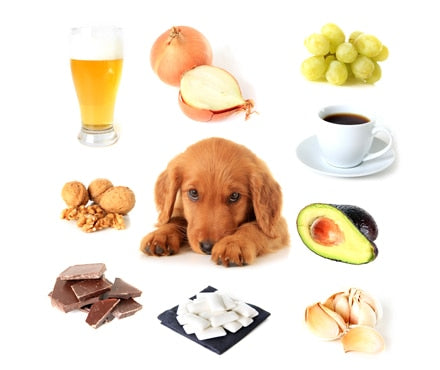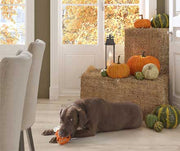Top Household Hazards for Your Pet

If you're reading this article, there's no doubt you love your pet. You want to protect them from any harm, and since they spend the majority of their time in your home, it should be a safe haven. However, there are many dangers within your home that you should be mindful of. Many of these potential hazards are fairly obvious, and are similar to what you would be concerned about if you had a small child in the house. Many common domestic items are specifically dangerous to your furry friends. Whether it's food, pharmaceuticals, or chemicals, keep an eye out for these top household hazards for your pets.

Edibles: Some food products that we regularly consume may not be optimal for our health, but they are usually acceptable in moderation. That is not the case with dogs and cats. Some of these items can be extremely toxic, or even fatal to your dog or cat. Some edibles that are considered healthy for us, can have very negative effects on our pets.
Chocolate: No surprise here. Even if you're not a pet owner, you probably knew this. Chocolate is harmful to both dogs and cats. Due to the caffeine and theobromine, never share chocolate – especially dark – or anything that contains caffeine with your furry friend.
Grapes: Healthy snack for us, but they can cause kidney failure in your dog. Since raisins are dried grapes, be sure to avoid those as well.
Chicken Bones: Although we often think of bones as good treats for dogs, chicken bones can splinter and cause choking in both dogs and cats.
Alcohol: In excess, alcohol is certainly not good for humans. It is never a good idea to give even a little bit to your pet. Like us, it can cause liver damage, but much quicker and more severely. It can also cause acidosis and even brain damage.
Avocado: This is one is highly debated among pet parents. Avocado contains a toxin called persin, which is toxic to many animals. It is always wise to err on the side of caution, and not feed your dog or cat anything that contains avocado – that means no guacamole either.
Fat and Trimmings: While it may be tempting to give your pet a little leftover fat from your steak, it is never a good idea to routinely expose your dog or cat to fatty foods. Fat trimmings from meat, both cooked and uncooked. It can cause pancreatitis, renal failure, and can be difficult for them to digest.
Onions & Garlic: Of these two, onions are definitely more dangerous for your pet. Both garlic and onions contain thiosulphate, which can cause gastrointestinal irritation, and could lead to red blood cell damage, in both dogs and cats.
Xylitol: This is a sweetener found in many common items like gum, candy, baked goods, and toothpaste. Ingestion could lead to liver failure and hypoglycemia. So, be sure to properly dispose of your gum next time it runs out of flavor.
A more in-depth list can be found here.
Medicine and Pharmaceuticals: Unless you've been told by a veterinary professional, medicine meant for humans should never be shared with your pet. Even the most harmless over-the-counter drugs for us can be very toxic to your pets. Make sure these items are all out of reach and be sure to pick up every pill if you drop any on the floor. Even things prescribed to your pet by a veterinarian should be kept inaccessible to your pet. Since these medicines are often flavored, your pet may want to eat the whole bottle if they are able to.
Chemicals and Cleaners: As you might expect, anything that is used to get rid of pests, clean your house, or keep your car running properly should certainly be kept away from pets.
Insecticides & Rodenticides: These items are meant to exterminate pests. Understandably, they could have devastating effects on your pet. Be sure to read the warning labels and store these items properly.
Cleaning Products: Bleach, window cleaners, bathroom cleaners, detergent, and most other cleaning products should not be kept in low areas unless they are properly pet-proofed. You may only think of this being necessary with small children, but pets can be just as curious.
Heavy Metals: paint chips, pennies, and other items found in the house can contain lead and zinc. If ingested, these items can lead to various complications.
Fertilizer & Mulch: Phosphorus and nitrogen are just a couple of the ingredients in fertilizer that can lead to a trip to the vet. Like chocolate, cocoa mulch contains theobromine, and as we mentioned earlier, this is very toxic for your pets. It even smells like chocolate, so pet parents should consider another type of mulch for landscaping.
Antifreeze: With a sweet odor and taste, many pets are attracted to it, but only a few tablespoons can put your pet's life in jeopardy. It only takes a small amount to cause fatal damage to the brain, liver, and kidneys.
Deicers: During the winter months, you might have this product on your sidewalks and driveways. This means your pet may have it on their paws, and if they lick it, it can lead to your pet being poisoned.
Miscellaneous :The chemicals or small parts found in batteries, toys, fabric softener sheets, and certain plants may pose a danger to your furry friend.
If you believe your pet may have ingested any of the items on this list, please contact your veterinarian or a pet poison hotline immediately. ASPCA's Animal Poison Control hotline number is (888)426-4435. If you have to take your pet to the veterinarian, it is recommended that you take a sample of the substance they ingested. You can see the Animal Humane Society's more in-depth list of household dangers to your pet, here.
This list certainly may look a bit menacing, but with a little extra precaution, you can certainly have peace of mind knowing that your pet is safe in your home – as they should be.
Sources:
- Common Household Poisons, Vet Street. 07 March 2014. Web. 03 Feb. 2016
- Most Dangerous Household Items for Dogs, Rover Daily Treat. 25 Nov. 2014. Web. 03 Feb. 2016
- Common Household Dangers for Pets, The Humane Society. 27 Feb. 2015. Web. 03 Feb. 2016
- People Food to Avoid Feeding Your Pets, ASPCA. Web. 03 Feb. 2016
Previous article

Next article

Related posts
View all-

Holiday Gifts for Every Pet Personality: The Ultimate Guide
The holiday season is finally here, and for many of us, that means finding the perfect presents for the ones we love most—our pets. Whether they are a steadfast dog who never leaves your side or an independent cat who graces you with their presence on their own terms, our pets are cherished members of the family. They deserve to celebrate right alongside us, stocking stuffers and all.
Read Article -

How to Keep Your Pet Calm During Thanksgiving
Thanksgiving is a time for family, friends, and food, but for our pets, the holiday can be overwhelming. The sudden change in routine, unfamiliar faces and scents, and increased noise can trigger significant stress. Understanding why your pet might feel anxious is the first step toward creating a peaceful holiday experience for everyone, including your furry family members. This guide offers calming tips for pets and practical solutions to ensure your dog or cat feels safe and secure during the festivities.
Read Article -

Top Travel Essentials for Pets This Holiday Season
Holiday travel often means bringing the whole family along, and for many of us, that includes our furry companions. Preparing for holiday pet travel is about more than just packing a bag; it's about ensuring your pet's safety, comfort, and happiness from the moment you leave home until you return. A little planning helps reduce stress for both you and your pet, making the journey a positive experience for everyone involved.
Read Article



